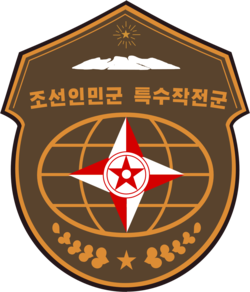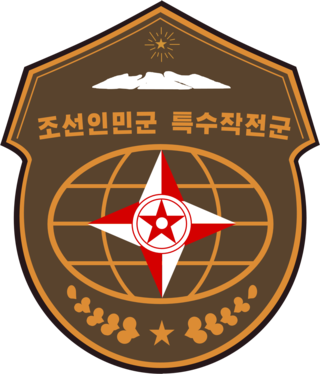Korean People's Army Special Operations Forces
North Korean military unit From Wikipedia, the free encyclopedia
The Korean People's Army Special Operations Forces (KPASOF; Korean: 조선인민군 특수작전군; Hanja: 朝鮮人民軍 特殊作戰軍; Chosŏn-inmin'gun teugsujagjeongun) are the special operations forces of Korean People's Army. It performs military, political, and psychological operations.
| Korean People's Army Special Operations Forces | |
|---|---|
| 조선인민군 특수작전군 朝鮮人民軍 特殊作戰軍 Chosŏn-inmin'gun teugsujagjeongun | |
 Patch of the Korean People's Army Special Operations Forces (2022–) | |
| Active | 30 October 1968–present |
| Country | Democratic People's Republic of Korea |
| Allegiance | Workers' Party of Korea |
| Type | Special operations |
| Role | Special operations |
| Size | 200,000[1][2][3] |
| Part of | Korean People's Army |
| Commanders | |
| Chief of the General Staff | Korean People's Army Vice Admiral Ri Yong-gil |
| Commander-in-Chief of the Special Operations Forces | Colonel General Kim Yong Bok |
History
North Korean special operations forces existed by late-1968 when maritime commandos made the unsuccessful Uljin–Samcheok Landings against South Korea.[4] A new special operations unit wearing what appeared to be modern combat gear appeared in the Day of the Sun military parade on 15 April 2017.[5] According to North Korean state media, the new unit, the Lightning Commandos, was intended to counter the U.S. Navy SEALs and Republic of Korea Navy Special Warfare Flotilla.[6][7]
On July 27, 2023, soldiers from the 41st Amphibious Assault Battalion marched during a military parade.[8]
Elements of the KPASOF have been deployed to Russia as a part of the North Korean involvement in the Russian invasion of Ukraine.[9]
Weapons
| Name | Country of origin | Type | Notes |
|---|---|---|---|
| M1911 pistol | Semi-automatic pistol | Locally made copy.[10] | |
| Baek Du San | CZ-75 copy;[11][12][13] the KPASOF exclusive version features a larger magazine base plate and features a tactical wooden grip in a chest holster[citation needed] | ||
| Sterling submachine gun | Submachine gun | [citation needed] | |
| vz.61 | [14] | ||
| AK-105 | Carbine | Locally produced copies.[15] Features include a shortened gas tube, barrel and muzzle brake with top folding stock[16] | |
| Type 88 | Assault rifle | Standard issue KPA rifle, AK-74 copy, used with top folding stocks and helical magazine attached[17] | |
| M16A1 | Locally made copies or some provided to North Korea through Vietnam;[14] spotted during the 1996 Gangneung submarine infiltration incident[18][19] | ||
| K2 | Locally made copies in production since the 1990s.[20] |
Organization
Summarize
Perspective
Mission
The missions of the KPA Special Operations Forces are to breach the fixed defense of South Korea, to create a "second front" in the enemy's rear area, and to conduct battlefield and strategic reconnaissance.[21][22]
Airborne
The Antonov An-2 transport aircraft is used for infiltration.[23]
Reconnaissance Brigades
Sometimes known as "sniper" brigades,[according to whom?] they are part of the ground intelligence effort of the KPA.[23] Additionally, it is suspected [according to whom?] that these units carry out assassination attempts.[23]
Maritime SOF
A 1998 U.S. Army estimate assessed that the North Koreans can deliver over 7,000 SOF personnel to each of South Korea's coastlines.[24] Based on the number of ships available to the KPA special forces, they could deliver 5,000 of these soldiers in one lift (approximately 102 amphibious craft).[23] It is expected that these special forces once ashore, will attempt to infiltrate South Korea's rugged terrain to attack the South Koreans in their rear areas just before and during the renewed commencement of hostilities between the two countries.[23] The KPA Navy has 24 Romeo class diesel electric submarines.[23] as well as specially outfitted Sang-O class submarines for coastal infiltrations. Finally, the KPA Navy possesses at least forty-five midget submarines for infiltrating two to five man teams into South Korean territory.[25]
References
Bibliography
Wikiwand - on
Seamless Wikipedia browsing. On steroids.
